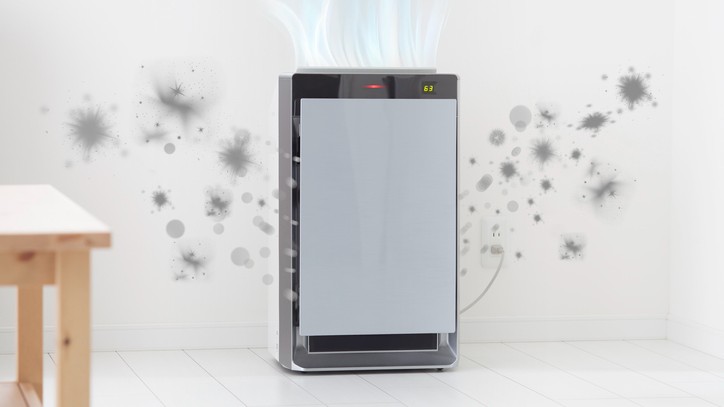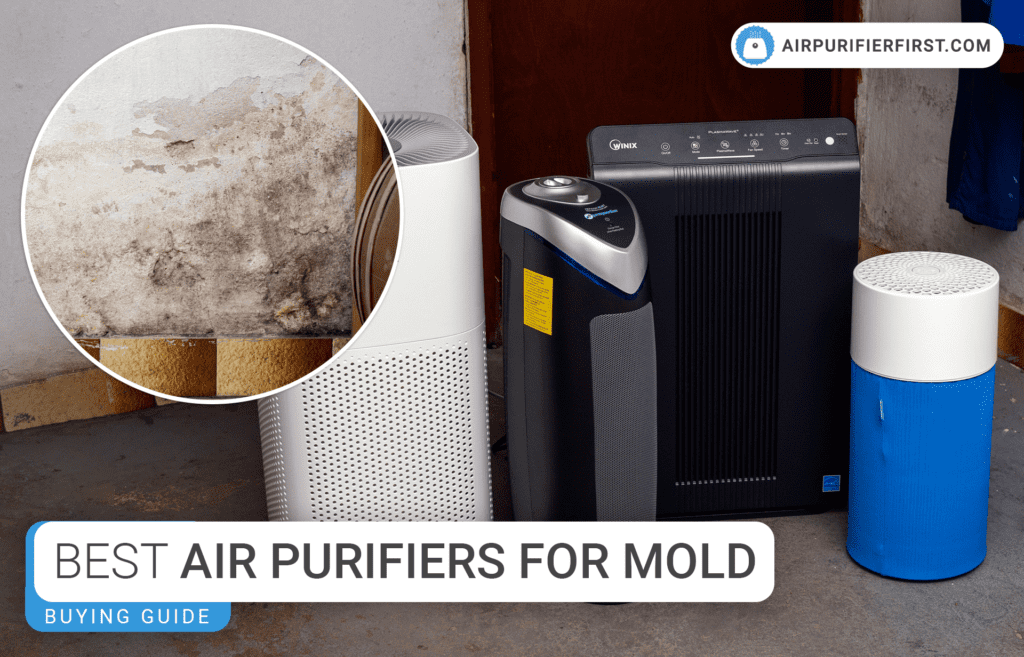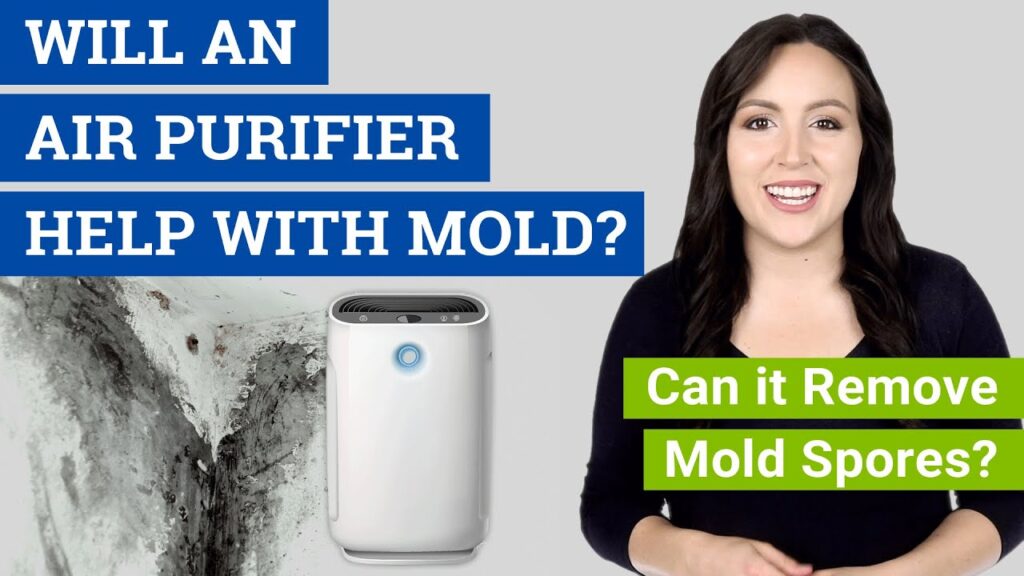If you’ve ever wondered about the effectiveness of air purifiers when it comes to tackling mold, you’re not alone. Mold can be a persistent and bothersome issue, especially in damp and humid environments. But let’s explore whether or not air purifiers are truly capable of helping you combat this pesky problem.

Understanding Mold
What is mold?
Mold is a common type of fungus that grows in damp and humid environments. It can be found both indoors and outdoors, and it thrives in areas with moisture, such as bathrooms, basements, and kitchens. Mold can appear in various colors, including black, green, or white.
The dangers of mold
While mold may seem harmless at first glance, it can pose serious risks to your health and the integrity of your home. Mold releases spores into the air, which can cause allergic reactions, respiratory issues, and even infections in some individuals. Prolonged exposure to mold can lead to chronic health problems, particularly for those with weakened immune systems or pre-existing respiratory conditions.
Additionally, mold can also cause structural damage to your home. It can weaken the foundation, walls, and ceilings, leading to potential costly repairs. Therefore, it is important to address mold growth promptly and effectively.
Common causes of mold growth
Understanding the common causes of mold growth is essential in preventing its occurrence. Excessive moisture is the primary factor that contributes to mold growth. This can result from high humidity levels, water leaks, condensation, or inadequate ventilation. Areas prone to moisture buildup, such as bathrooms, kitchens, and basements, are particularly vulnerable to mold growth.
Other contributing factors include inadequate insulation, poor drainage, and water intrusion from leaky pipes or roofs. It is crucial to address these underlying issues to prevent mold from infiltrating your living space.
How Air Purifiers Work
Types of air purifiers
Air purifiers are equipped with various technologies and mechanisms to remove pollutants from the air, including mold spores. The most common types of air purifiers include:
-
High-Efficiency Particulate Air (HEPA) purifiers: These air purifiers utilize a fine mesh filter that captures microscopic particles, including mold spores.
-
Activated carbon purifiers: These purifiers contain activated carbon filters that effectively remove odors and chemicals, often associated with mold growth.
-
Ultraviolet Germicidal Irradiation (UVGI) purifiers: UVGI purifiers use ultraviolet light to kill mold spores and other airborne pathogens.
Filtration mechanisms
Air purifiers employ different filtration mechanisms to capture and eliminate mold spores from the air. One of the most effective and widely used filtration methods is HEPA filtration. HEPA filters can capture particles as small as 0.3 microns with a high efficiency of 99.97%. This includes mold spores, dust mites, pollen, pet dander, and other allergens.
Activated carbon filters are also commonly used in air purifiers to trap and absorb mold-related odors and volatile organic compounds (VOCs). These filters contain a highly porous form of carbon that chemically reacts with odorous substances, leading to their removal from the air.
Effectiveness in removing mold spores
Air purifiers, especially those with HEPA filters, are effective in removing mold spores from the air. Mold spores range in size from 1 to 30 microns, and HEPA filters have the capability to capture particles as small as 0.3 microns. This ensures that the majority of mold spores present in the air are trapped and removed, reducing the risk of inhalation and further mold growth.
It is important to note that air purifiers are not a standalone solution for complete mold removal. They primarily target airborne mold spores and may have limited effectiveness in dealing with mold growth on surfaces or hidden within walls or other structures. Mold remediation often requires a combination of interventions, including identifying and addressing the source of moisture, proper cleaning methods, and, if necessary, professional assistance.

Air Purifiers and Mold Removal
Prevention vs. removal
When it comes to mold, prevention is always better than removal. Taking proactive measures to prevent mold growth is essential for maintaining a healthy indoor environment. However, if mold does develop, it is crucial to address it promptly to prevent further damage and potential health risks.
Air purifiers primarily aid in preventing the spread of mold spores and reducing their concentration in the air. By effectively capturing and eliminating airborne mold spores, air purifiers help to create a healthier living environment and minimize the chances of mold-related health issues.
Can air purifiers remove existing mold?
While air purifiers can help prevent the spread of mold spores, they are not designed to remove existing mold growth entirely. Mold that has already settled on surfaces or infiltrated building materials requires targeted cleaning and remediation techniques.
In cases of small isolated mold growth, such as on bathroom tiles or in localized areas, thorough cleaning using appropriate mold cleaners can be effective. However, for extensive mold infestations or mold hidden within walls or other structures, professional mold remediation services should be sought. These professionals have the necessary expertise and equipment to safely remove mold and prevent further contamination.
Limitations of air purifiers for mold removal
Air purifiers have certain limitations when it comes to mold removal. They cannot eliminate mold spores completely, as some spores may be too large to be captured by the filtration system. Additionally, air purifiers are unable to address mold growth hidden within walls, ceilings, or other inaccessible areas. Mold remediation in these cases often requires a comprehensive approach that involves identifying and resolving moisture sources, removing affected materials, and thorough cleaning and disinfection.
Therefore, while air purifiers can be a valuable tool in managing mold, it is essential to complement their use with other preventive measures and appropriate remediation methods for a comprehensive solution.
Choosing the Right Air Purifier
Considerations for mold prevention
When selecting an air purifier for mold prevention, several factors should be taken into consideration:
-
Coverage area: Determine the square footage of the area where the air purifier will be used. This will help you choose a purifier with the appropriate capacity to effectively clean the air.
-
Filtration system: Opt for an air purifier with a HEPA filter to ensure efficient capture and removal of mold spores. Activated carbon filters can also be beneficial in reducing mold-related odors.
-
Noise level: Consider the noise level of the air purifier, especially if it will be used in bedrooms or other quiet areas of the house.
-
Energy efficiency: Look for air purifiers with an Energy Star certification to ensure energy-efficient operation and cost savings in the long run.
Features to look for in an air purifier
Certain features can enhance the effectiveness and convenience of an air purifier for mold prevention. Consider the following features when choosing an air purifier:
-
Automatic features: Look for air purifiers with automatic sensors that adjust fan speed based on air quality, as this ensures optimized performance.
-
Timer function: A timer allows you to set desired operating hours for the air purifier, providing flexibility and energy savings.
-
Filter replacement indicator: An indicator that alerts you when the filters need to be replaced simplifies maintenance and ensures continued effectiveness.
-
Multiple fan speeds: Air purifiers with adjustable fan speeds allow you to customize the purification process based on the specific needs of the environment.
Finding the right size and capacity
Proper sizing and capacity of an air purifier are essential for achieving optimal results in mold prevention. Consider the square footage of the room or area where the air purifier will be used. Each air purifier has a suggested coverage area, which indicates the maximum size of the room it can effectively clean.
To determine the appropriate size, match the square footage of the room to the coverage area specified by the manufacturer. Keep in mind that using an undersized air purifier may result in inadequate purification, while an oversized unit may consume excessive energy without providing additional benefits.

Tips for Using Air Purifiers for Mold
Placement of air purifiers
Proper placement of air purifiers is crucial for their effective operation. Consider the following tips when positioning your air purifier:
-
Central location: Place the air purifier in the central area of the room to ensure maximum air circulation and coverage.
-
Avoid obstructions: Keep the air purifier at least a foot away from walls, furniture, or other objects to allow adequate airflow and distribution of purified air.
-
Close doors and windows: To prevent outside contaminants from entering the room, ensure that doors and windows are closed while the air purifier is in operation.
Maintenance and filter replacement
Regular maintenance and filter replacement are essential for the continued effectiveness of your air purifier. Follow these maintenance tips to ensure optimal performance:
-
Clean the exterior: Wipe the exterior of the air purifier with a soft, damp cloth regularly to remove dust and debris.
-
Clean the filters: Some air purifiers have washable filters that require periodic cleaning. Refer to the manufacturer’s instructions for proper cleaning techniques.
-
Replace filters as recommended: Most air purifiers utilize replaceable filters, and the frequency of replacement depends on the manufacturer’s recommendations. Regularly monitor the filter condition and replace them as needed to maintain optimal filtration efficiency.
Combining air purification with other mold prevention methods
To maximize the effectiveness of air purifiers in mold prevention, it is advisable to combine their use with other preventative measures. Consider the following strategies:
-
Control moisture levels: Address any moisture-related issues, such as leaks or condensation, to minimize the potential for mold growth. Monitor humidity levels and use dehumidifiers or ventilation systems to maintain optimal moisture levels.
-
Improve ventilation: Proper ventilation helps to minimize humidity and increase airflow, reducing the likelihood of mold growth. Use exhaust fans in high-moisture areas like bathrooms and kitchens, and make sure ventilation systems are clean and functional.
-
Regular cleaning and maintenance: Maintain cleanliness throughout your home by regularly cleaning and drying areas prone to moisture, such as bathrooms and basements. Additionally, promptly address any water leaks or spills to prevent mold growth.
Potential Benefits of Air Purifiers for Mold
Improving indoor air quality
Air purifiers play a crucial role in improving indoor air quality by removing airborne contaminants, including mold spores. By reducing the concentration of mold spores in the air, air purifiers help create a healthier living environment and reduce the risk of mold-related health issues.
Reducing mold-related allergies
For individuals with mold allergies, exposure to mold spores can trigger allergic reactions, such as sneezing, coughing, and itchy eyes. Air purifiers with HEPA filters effectively trap and remove mold spores from the air, providing relief from mold-related allergies and improving overall well-being.
Preventing mold growth on surfaces
By capturing and eliminating mold spores from the air, air purifiers help prevent the settling of mold on surfaces. Controlling the concentration of mold spores in the air reduces the likelihood of mold growth on walls, furniture, and other surfaces, crucially minimizing potential damage and the need for extensive remediation.

Effectiveness of Air Purifiers for Mold
Studies and research
Several studies and research support the effectiveness of air purifiers in reducing mold spores in indoor environments. These studies have demonstrated significant reductions in airborne mold spore concentrations after air purifier operation, leading to improved indoor air quality.
The researchers have consistently found that air purifiers equipped with HEPA filters, in particular, are highly effective in capturing and removing airborne mold spores. However, it is important to note that the efficiency of air purifiers can vary based on factors such as the size of the room, air circulation patterns, and overall maintenance of the device.
Real-world experiences and testimonials
Numerous individuals have experienced the benefits of air purifiers in mold prevention firsthand. Testimonials from users highlight the noticeable improvements in air quality, reduced mold-related symptoms, and a decrease in the recurrence of mold growth with the use of air purifiers.
These personal experiences reinforce the value of air purifiers as a practical and effective tool in managing mold in both residential and commercial settings.
Factors that can affect the effectiveness
While air purifiers are effective in capturing and removing mold spores, certain factors can influence their overall effectiveness. These factors include:
-
Air purifier placement: Improper placement of the air purifier can hinder its ability to effectively circulate and purify the air. It is crucial to follow the manufacturer’s guidelines for optimal placement.
-
Maintenance and filter replacement: Regular maintenance and timely filter replacement are crucial for maintaining the efficiency of an air purifier. Neglecting these tasks can compromise its effectiveness in removing mold spores.
-
Room size and coverage area: Air purifiers have specific coverage areas that determine their effectiveness in cleaning the air. Using an air purifier with inadequate coverage for a larger space may result in suboptimal performance.
Limitations of Air Purifiers for Mold
Inability to address mold hidden in walls or other structures
One of the primary limitations of air purifiers is their inability to address mold growth hidden within walls, ceilings, or other structures. Mold that infiltrates these areas often requires comprehensive remediation methods involving professional assistance and targeted removal of affected materials.
While air purifiers effectively capture mold spores in the air, they cannot directly address mold growth that has already occurred on surfaces or within hidden spaces. It is crucial to combine air purifiers with other remediation strategies to fully address mold issues.
Air purifiers cannot eliminate mold spores completely
Despite their efficiency in capturing and removing mold spores from the air, air purifiers cannot completely eliminate mold spores. Mold spores are ubiquitous and can enter the indoor environment through various sources, such as open windows, ventilation systems, or on clothing and pets.
While air purifiers can significantly reduce the concentration of mold spores, it is important to note that complete elimination is not achievable. Proper mold prevention measures and maintenance are necessary to minimize the risk of mold growth.
Not a standalone solution for mold remediation
Air purifiers should not be relied upon as a standalone solution for mold remediation. While they can aid in preventing the spread of mold spores and reducing their concentration in the air, they do not address the underlying causes of mold growth or remove existing mold growth entirely.
To effectively remediate mold, it is essential to identify and address the source of moisture, physically remove the affected materials if necessary, and properly clean and disinfect the area. Professional mold remediation services may be required for extensive or hidden mold infestations.

Other Strategies for Mold Prevention
Controlling moisture levels
Controlling moisture levels is crucial in preventing mold growth. Consider the following strategies to minimize excessive moisture:
-
Monitor humidity: Use a hygrometer to monitor humidity levels in your home. Maintain indoor humidity levels below 50% to inhibit mold growth.
-
Fix leaks promptly: Address any water leaks or plumbing issues as soon as they are detected. Prompt repairs prevent moisture buildup and minimize the risk of mold growth.
-
Use dehumidifiers: In areas with high humidity, such as basements or bathrooms, use dehumidifiers to reduce moisture levels. Empty and clean the dehumidifier periodically to prevent mold growth within the device.
Improving ventilation
Proper ventilation is essential in preventing mold growth. Implement the following measures to improve ventilation:
-
Use exhaust fans: Install exhaust fans in high-moisture areas, such as bathrooms and kitchens, to remove excess humidity and improve air circulation.
-
Open windows: Regularly open windows to promote airflow and allow humidity to escape. Ensure proper seals and screens are in place to prevent the entry of outdoor contaminants.
-
Clean ventilation systems: Regularly clean and maintain ventilation systems, including air ducts and filters, to prevent the accumulation of dust and mold spores.
Regular cleaning and maintenance
Regular cleaning and maintenance practices are essential in preventing mold growth. Follow these guidelines for effective mold prevention:
-
Clean and dry wet areas: Promptly clean and dry areas prone to moisture, such as bathrooms, kitchens, and basements. Pay attention to areas around sinks, showers, and toilets.
-
Use mold-resistant materials: When renovating or choosing building materials, opt for mold-resistant options that discourage mold growth, such as mold-resistant drywall or paint.
-
Regularly clean and vacuum: Regularly clean surfaces and vacuum carpets and upholstery to eliminate dust, pollen, and other potential sources of mold spores.
Conclusion
Air purifiers can be valuable tools in managing mold by effectively capturing and removing mold spores from the air. They play a significant role in improving indoor air quality, reducing the risk of mold-related allergies, and preventing mold growth on surfaces. However, it is important to recognize that air purifiers have certain limitations and should be used as part of a comprehensive approach to mold prevention and remediation.
Addressing the underlying causes of mold growth, such as controlling moisture levels, improving ventilation, and regular cleaning and maintenance, is crucial in conjunction with the use of air purifiers. By combining these strategies, you can create a healthier living environment and minimize the risks associated with mold. Remember to choose the right air purifier based on your specific needs, ensure proper placement and maintenance, and seek professional assistance for extensive or hidden mold infestations. With a proactive approach, you can effectively manage mold and maintain a mold-free home.